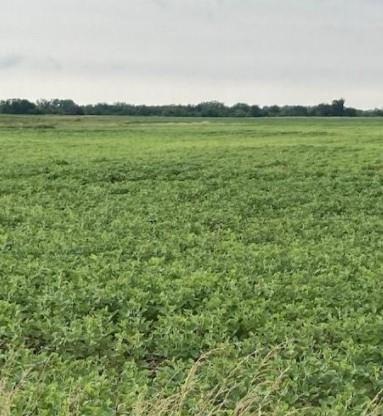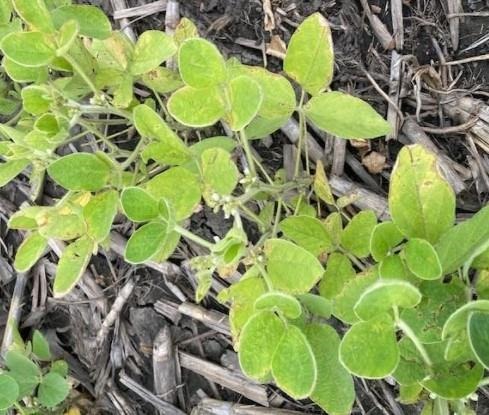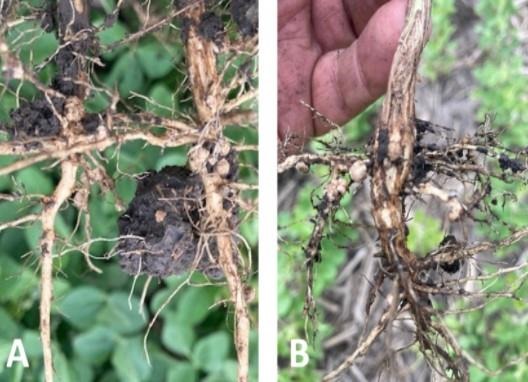By Antonio Mallarino
Rainfall has been extremely variable this season in Iowa. There has been severe drought in many areas of Iowa. In contrast, rainfall has been excessive in some areas of southeast and southern Iowa. Soybean with poor growth with pale green or yellowish color has been observed in low-laying fields or field depressions with poor drainage and frequent waterlogged soils since May.
Many things can cause these symptoms in soybean, such as deficiencies of several nutrients, diseases, herbicide injury, and severe soybean cyst nematode infestations. Some of these causes with photos as examples have been addressed in Iowa State University Extension and Outreach publications such as IPM 42 Nutrient Deficiencies and Application Injuries in Field Crops, CSI 12 Soybean Cyst Nematode Field Guide, and the recent ICM Blog post What’s with all the yellow soybean?.
However, a very likely cause this season of soybean poor growth and symptoms in poorly drained soils with excess rainfall in southern Iowa is limited soil aeration combined with nitrogen (N) deficiency due to poor nodulation or inefficient nodule function. Soybean, as all legumes, needs lots of N, mostly supplied by rhizobia bacteria in the root nodules that transform atmospheric N into forms utilizable by microorganisms and plants. Waterlogging reduces oxygen levels in soils and nodules (anoxia), which limits plant cell respiration and, as a consequence, limits transformation of N gas into metabolizable N forms.
Figures 1 and 2 show panoramic and close-up photos, respectively, of typical soybean symptoms developed in poorly drained areas of a southern Iowa field taken July 9, 2021 by Mark Carlton, retired ISU Extension and Outreach field agronomist for the region. Both photos show poor growth and pale-green and yellow color of all soybean leaves in the affected areas.


Moreover, Figure 3 includes side by side photos of roots and nodules from normal and affected areas, showing smaller roots and fewer nodules for plants of the affected area.

The panoramic field view in Figure 1, with yellowish soybean in depressions but not in surrounding areas, often is observed in central to north central Iowa. Sometimes lack of aeration and N deficiency can be a contributing factor for these symptoms in this region, but are seen in both dry or wet years, more frequently and more severe in dry years, and is caused by iron chlorosis deficiency (IDC), which typically develops in the calcareous high-pH soils of those landscape positions. Figure 4 shows close-ups of typical IDC symptoms, which are different because they occur mainly in new leaves and often veins remain green.

What can you do about it?
When the wet and anoxic soil conditions aren’t too prolonged, the best is to “wait and see” because once the soil drains, plants recover and green up fast when N fixation by the nodules resumes and new nodules may form. If the excessively wet conditions last long and occur late in the season, N fixation may not recover sufficiently and the N deficiency will continue even after the soil dries.
The outcome of various N fertilization options is highly variable and often may not offset product and application costs. Research in Kansas and Michigan has shown that application of 50 to 70 lb N per acre as dribbled UAN or granulated urea can recover yield but not to the level of unaffected areas. Such low N rates are unlikely to inhibit new nodulation or N fixation. Iowa research has shown that foliar fertilization with common N-containing fluid fertilizers seldom is effective at increasing yield significantly. Nitrogen applications to the foliage must be low enough to avoid leaf injury, and multiple applications may not be cost-effective.
In the long term, the most cost-effective management options are to improve soil drainage and, if not practical or too costly, avoid planting soybean to these field areas.
Source : iastate.edu